Commentary 31 Jan 2012 07:57 am
False “Sincerity”
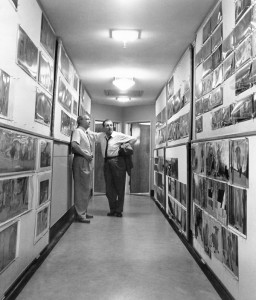 Mike Barrier, on his website, uses a photograph of Walt Disney talking in a corridor to Eric Larson to discuss the state of current day Disney. In the photo, both Walt and Eric are obviously tired at the end of a long and arduous day. Larson remembered, to Mike Barrier, that they were discussing the recently completed feature, Sleeping Beauty, and Walt surmised that at the current expense, he wouldn’t be able to continue to make animated features. That film had cost a bit more than four million dollars in 1958, a whopping sum. (Compare that to the $260 million Tangled cost in 2010.)
Mike Barrier, on his website, uses a photograph of Walt Disney talking in a corridor to Eric Larson to discuss the state of current day Disney. In the photo, both Walt and Eric are obviously tired at the end of a long and arduous day. Larson remembered, to Mike Barrier, that they were discussing the recently completed feature, Sleeping Beauty, and Walt surmised that at the current expense, he wouldn’t be able to continue to make animated features. That film had cost a bit more than four million dollars in 1958, a whopping sum. (Compare that to the $260 million Tangled cost in 2010.)
Mike Barrier‘s point in this article is that features, from that point on, took a slow dip in quality and never recovered. Mike says that he found a falseness setting in to the “sincerity” that Disney requested of his animators, with The Sword In the Stone and Jungle Book being virtually swallowed up by this false “sincerity”:
- “I think the falseness I saw was rooted, paradoxically, in that Disney shibboleth ‘sincerity.’ As Walt used the term, during work on the first great features, it was the characters who were to be sincere, that is, to seem to move of their own volition. Over the years, sincerity came to be valued less in the characters than in their animators (and, at one step removed, their directors), until now we are supposed to admire animation because its practitioners—assuming a high level of technical skill—are conspicuously earnest, in a way that many of the great early Disney animators were not.”
I have to agree, for the most part, with this theory. I think it most obvious in the Jungle Book. With The Aristocats, to me, they’d sunk completely and hopelessly off the map. I’ve sat through this film at least half a dozen times and have not been able to stay awake throughout it. The film is not one of my favorites.
Mike Barrier takes The Sword In the Stone as the first full on example of this problem, whereas I love that film, though I admit that it has significant problems. I agree with him on the next one, The Jungle Book, but Andreas Deja would disagree heartily – it was this film that convinced him to become an animator.
I remember discussing Beauty and the Beast with John Canemaker and my saying that I had trouble enjoying it, finding an ugliness in most of the characters – those townspeople cannot be drawn more poorly. But then John asked me if I didn’t think that this would be a film that would encourage lots of young people to want to become animators just as we had been inspired by some of the films of the fifties. It was obvious that I had to agree immediately.
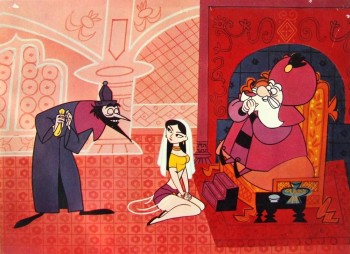 I recognize that The Sword In the Stone was right at the time that I was in love with most of the fare coming out of Disney’s studio, as a matter of fact out of most studios. 1001 Arabian Nights with Mr. Magoo was certainly an influence on me.
I recognize that The Sword In the Stone was right at the time that I was in love with most of the fare coming out of Disney’s studio, as a matter of fact out of most studios. 1001 Arabian Nights with Mr. Magoo was certainly an influence on me.
One of those commenting on Barrier’s column, Garry Apgar, points to Ichabod and Mr. Toad as one of the best of the Disney films, “I was enthralled by the magic of both, and to this day consider the Toad half of that combo picture, “pound for pound” . . . the greatest Disney cartoon ever. I still have the Giant Golden Book edition of that story.”
Personally, except for the ride of the Headless Horseman, I find very little inspiring in that feature. I’d guess that Mr. Apgar was influenced because he saw the film at a time when he was strongly influenced by it, just as I saw The Sword In the Stone at a susceptible time in my life. However, despite that, I have difficulty finding much bad in the film. Yes, I hear odd echos in some of the voice track; the music is completely anachronistic, and some of the animation is not up to the work of the past. I’ll even say that I have a major problem with the wizards’ duel in that the mad Madame Mim is introduced late in the film just for the sake of the set piece, the duel. She’s then dismissed. I have always found that a wart in the storytelling. Somehow the late introduction of the squirrel females doesn’t bother me. Perhaps because they’re squirrels.
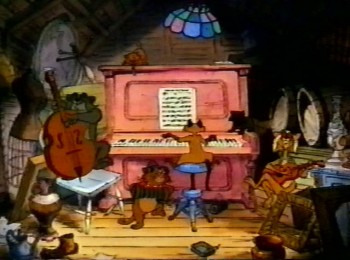 Basically, I’m saying that we’re all affected by our influences – not necessarily the quality of the actual film. Those who have seen The Aristocats at a vulnerable time in their lives, probably like that movie, and I can’t really fault them though I know it’s not a benchmark in Disney animation, and, in fact, is definitive proof of Barrier’s theory about the false “sincerity” in the animators’ work and, more to the point, the director’s work. (I can remember Ken Anderson, Frank Thomas and Ollie Johnston talking about the disco-lights used in the jazz-in-the-attic section of the film. Woolie Reitherman could not be coaxed out of the 70s effect despite the fact that it was already dated when the film was released.)
Basically, I’m saying that we’re all affected by our influences – not necessarily the quality of the actual film. Those who have seen The Aristocats at a vulnerable time in their lives, probably like that movie, and I can’t really fault them though I know it’s not a benchmark in Disney animation, and, in fact, is definitive proof of Barrier’s theory about the false “sincerity” in the animators’ work and, more to the point, the director’s work. (I can remember Ken Anderson, Frank Thomas and Ollie Johnston talking about the disco-lights used in the jazz-in-the-attic section of the film. Woolie Reitherman could not be coaxed out of the 70s effect despite the fact that it was already dated when the film was released.)
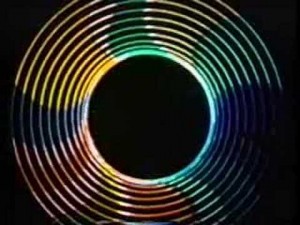 But back to the comments section of Mike Barrier’s site. Jim Korkis was surprised while teaching Animation History to a number of young interns at the Disney studio. “They had no acquaintance with any silent animated cartoons that were the foundation nor any of Walt’s competitors in the Thirties and Forties like Paul Terry, Warner Brothers, MGM and others. Even as the class approached the beginning of computer animation, they had no clue how and why computer animation developed.”
But back to the comments section of Mike Barrier’s site. Jim Korkis was surprised while teaching Animation History to a number of young interns at the Disney studio. “They had no acquaintance with any silent animated cartoons that were the foundation nor any of Walt’s competitors in the Thirties and Forties like Paul Terry, Warner Brothers, MGM and others. Even as the class approached the beginning of computer animation, they had no clue how and why computer animation developed.”
This has become the state of the world. It’s not only animation. Just focusing on the Arts, I see it everywhere.
- There’s no knowledge of Vaudeville among the young performers and creators trying to sell their wares to theatrical shows. When Stephen Sondheim, Charles Strouse and John Kander die so will the history of the theater.
- I wonder how many architecture students have read Ayn Rand’s “The Fountainhead.” Certainly not for the confused libertarian views, but for the threat of two different architectural forces that dominated the world in the early Twentieth Century.
- How many Fine Artists explore early Renaissance Art, except within their Art History classes? Do they question why and how Daumier painted as he did? What about Turner, do they understand what he was trying to do? Or David? This is our history; it’s the foundation of the future. Only by going through his apprenticeship to Thomas Hart Benton could Pollock paint his splatter paintings.
Animation students should do more than study scenes that have already been animated. By limiting yourself to how Milt Kahl or Tex Avery did something, you’ve eliminated the world. This is what you’re caricaturing in your animation, I should think. Regurgitated Jim Tyer is not only not art but it’s not Jim Tyer. And it’s not good. Art Babbitt, while at the Disney studio, took piano lessons and dance lessons knowing that it would help his animation, and undoubtedly it did. It’s more important to take those dance lessons (and more fun, too) than it is to study all of Tytla’s scenes.
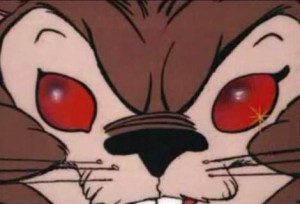 I’m not saying that animators shouldn’t study past animation, but what I am saying is that it’s the world outside your body that is shaping any artistry within you. Imitating Chuck Jones’ blinks won’t help you other than knowing that Jones did it that way.
I’m not saying that animators shouldn’t study past animation, but what I am saying is that it’s the world outside your body that is shaping any artistry within you. Imitating Chuck Jones’ blinks won’t help you other than knowing that Jones did it that way.
Learn about your business, but also learn about the world. That’s the only way you can relate to how your character should think and emote. All of the Disney drawings on this site and other ones really won’t help you figure out YOUR character’s development. Only you can do that.

on 31 Jan 2012 at 11:18 am 1.Eric Noble said …
Thank you for that Mr. Sporn. This is an inspiration. I think this is also why so much animation seems so derivative at times. it’s not just executive meddling. It’s that a lot of people in the business are copying what their predecessors did, albeit with more bells and whistles. A lot of the current big names in animation (and comics as well) need to gain more life experience and broaden their minds. It will every artist a world of good to do that.
on 31 Jan 2012 at 11:48 am 2.richard o'connor said …
Your point about “vulnerability” leads me to wonder about the responsibility of the filmmaker -especially one who’s consciously gearing their work towards children.
In many ways the “lesser” films you cite take advantage of a viewer’s vulnerability -these things don’t need to make sense, or be well done, or speak to an intelligent level because the viewer is beneath them. Compare to “Snow White” or “Dumbo” and others in which the audience is essentially exalted and presented with compelling work that challenges rather than simply comforts and assuages that vulnerability.
on 31 Jan 2012 at 12:24 pm 3.Charles Kenny said …
I’m reminded of a quote by MAD art director Sam Viviano who stated that MAD was at it’s creative peak “whenever you first started reading it”.
The same could easily be said for Disney animation, with films from a particular time being seen as ‘the best’ by those for whom it was their first exposure to animation.
That doesn’t excuse someone not having an interest in the past though. But the problem is that the benefits are not immediately clear.
Students focusing on imitating a particular style are either poor students or they’re receiving a poor education; the point of which is to develop the mind to the extent that the student develops their own style from their own skills and personal lives. It’s an aspect that causes the best do to stand out from the crowd, just as they’ve always done.
Unfortunately in this world of cost-control and ROI (return on investment), for a major studio like Disney, unless middle management can compute and quantify the benefits, they’re unlikely to encourage employees to do likewise; leaving the product to suffer as a result.
on 31 Jan 2012 at 1:36 pm 4.Ray Kosarin said …
Amen.
on 31 Jan 2012 at 3:44 pm 5.Larry Ruppel said …
It’s so true… Animators- Get A Life! Then put it on film (or video)!
on 31 Jan 2012 at 4:22 pm 6.Mark Sonntag said …
I love Sword in the Stone too, it’s a simple film and for me the xerox look works very well. Yes it’s not Snow White or Bambi or something like that but it is quite charming. I agree that Jungle Book seems forced, but it did have a troubled history.
I think we should remember that Jungle Book was quite a hit, my father loved it, it was his favorite Disney movie, but I also remember it as being re-released more often along with Sword in the Stone and funny enough Song of the South. I imahine it could be why many animators reference Jungle Book as the start for them. By the way Pierre Lambert released a great Jungle Book art book a few years ago.
In terms of repeating ourselves, Brad Bird once said in a lecture that he felt it best to watch live action and the things around you than just animation. Live action movies, the Don Graham classes and the numerous lectures are all the nine old men and company had when they did their best work.
on 31 Jan 2012 at 5:19 pm 7.Howard Beckerman said …
Though there are many highlights in various Disney films from the ’50s to the ’80s, I came to feel that the downturn began after “The Three Caballeros.” It was after that point that the Disney style became repetitious. Someone once suggested to me that “When you know what you’re doing, you’re probably not doing anything new.” Or words to that effect. That’s what happened to the Disney approach and why UPA captured a large audience in the 1950s. From there on Disney animation,
which had inspired everyone else, was just trying to surpass itself in a changed world.
Howard
on 31 Jan 2012 at 5:31 pm 8.Robert Dress said …
Dear Mike,
I’d like to apologize for my cocky attitude when I presented my portfolio to you in your studio during the summer of 1998. You most likely don’t remember me. I showed you some Disney inspired characters and thought that I was great and worthy to work for you because of it. On top of that I thought because I took part in training at the first Disney Boot Camp for month I deserved a job on that fact alone. I was a real jerk. But you where very calm and reserved and gracious enough to look at my work. For that I thank you.
I believe in the things you mentioned in your latest post in particular “This has become the state of the world.” and onward. Thanks for your honesty and insight.
Best,
Robert
on 01 Feb 2012 at 5:03 am 9.slowtiger said …
My first animated movie was “Aristocats”, and for me this was the film which made me want to become an animator. I was about 8 or 9 when I saw it, and months afterwards I would still draw stuff from it. This may also explain my preference for that xeroxed pencil line I still have.
“Jungle Book” is said to be the most popular Disney film in Germany before “Beauty and the Beast” and the following blockbusters.
I completely agree with your view of today’s young artists. I use to give more or less the same advice when asked (and even more when not), not only to animators but also to graphic designers and musicians. Even myself I feel I don’t have learned enough yet for my own “art”, and only recently developed a feeling of having lived an interesting enough life to be able to maybe make interesting films.
On the other hand, what can I expect from a 20something student fresh from art school? She may or may not have had a colourful life yet, but that’s nothing she could do much about. The only thing she really is responsible for is her own openness and will to learn, and I make it a point to like those people more who at least try to broaden their horizon.
on 01 Feb 2012 at 4:45 pm 10.The Gee said …
In bringing up the point when audiences might first experience a particular animated production and being more willing or likely to accept it warts and all, that’s part of what I was getting at earlier when I wrote about how certain films are cherished.
I guess I’m being a stickler because the word “sincerity†is used.
With “sincerity†it not only depends upon the messenger but the recipient.
I guess “believabity†might be a better word because it really puts the onus on the animator. And, badly done animation will kick the audience out of the piece, be it a scene or a full length feature film. Well, maybe that isn’t 100 percent always true. There might still be some who accept the way it moves and the way the characters act and, as you mentioned, how they are developed.
Isn’t Performance very key to making something believable, and in turn, making something seem sincere? (and I don’t mean putting Life into the character but making the performance visually great with all the facets that entails which are obviously far beyond story and voice over)
But, then there is the knock on Don Bluth’s stuff….how does that fit into this all? A good example of what Barrier is getting at or not?
Chuck Jones’ stuff went the route of sentimentality, often. It wasn’t just cloying, with the close ups of the characters showing awareness of the audience or the blinks. It could get kind of smaltzy. And, that’s artifice for ya. The trick is to make it work as well as he did with “Feed the Kitty†(which might not be the best example because it was sentimentality played for gags).
Anyway, whatever…I just wanted to make that point.
on 01 Feb 2012 at 4:58 pm 11.Michael said …
Mike Barrier was writing about the Disney animators, with Milt Kahl as his best example. He states it in his article.
on 01 Feb 2012 at 5:39 pm 12.Stephen Worth said …
I’ve received criticism from animation professionals (admittedly, most of them were not artists) that Animation Resources includes too much other stuff besides animation- illustration, caricature, cartooning. I even had one animation teacher ask me what Playboy cartoons by Erich Sokol had to do with animation. My jaw hit the floor with that one.
Animation will never survive without a grounding in its cartooning and caricature roots. It will also not survive if we keep on recycling talking dog and princess stories and that damn Milt Kahl hand model sheet with the squared off fingers for all eternity. Animators need to see themselves as artists. They need to caricature the world around them the way cartoonists have been doing since Da Vinci.
That’s the point I’ve been trying to make for the past six years. I know a lot of kids that have taken it to heart. That gives me hope for the future.
on 01 Feb 2012 at 7:00 pm 13.The Gee said …
“…Mike Barrier was writing about the Disney animators, with Milt Kahl ….â€
Understood on that.
The last time I checked the comments on that thread, I think someone did bring up how “Lilo and Stitch†gave hope that there wasn’t only one way to approach the typical Disney feature animation, especially in terms of design.
The thing is, like you more or less mention in the initial posting about “vulnerable†impressionable points, the youngest audience doesn’t care as much about the design and the acting. And, from that point on it becomes nostalgic. ….which is why parents are taking their kids to the re-releases of the Beauty and the Beast.
(oh yeah, for what it is worth, I rather like “The Sword and the Stone.†Most of Disney’s features are not ones I was never enthusiastic about. But, the shorts, yes; And, I do like the boy’s stories.
“…Sword…”, like “Robin Hood†and “Pinocchio†are decent boy’s stories. So I’ve always been forgiving of them; blinded that way, too. ha.)
on 04 Feb 2012 at 2:41 am 14.Mark Sonntag said …
Stephen Worth, keep doing what your doing, I check every couple of months for inspiration. It’s funny over the past year I’ve been more interested in comic strip reprint volumes and orignals on e-bay than animation art books.
I once knew an animator who asked why watch Chaplin? It’s old fashioned. My answer, yes, but the principle of communication through mime is there in the actions of one of if not the greatest of mimes. And what is animation really, but a silent film with sound?
on 06 Feb 2012 at 4:18 pm 15.Floyd Norman said …
I have mixed feelings about “The Jungle Book.” I’m not sure whether to accept praise or blame for the film.
I never thought it was that good while working on it. However, the silly story seemed to please Walt who was in failing health. If the movie made him smile, that was good enough for me.